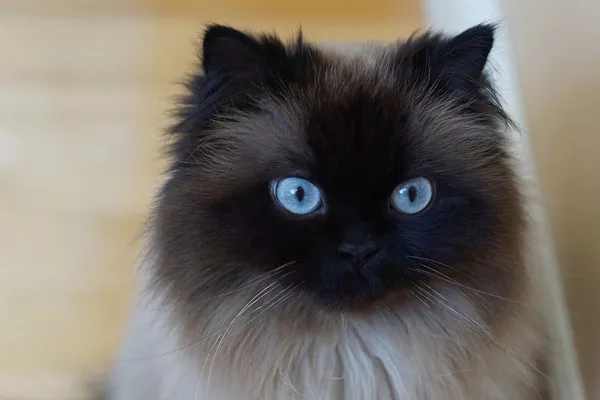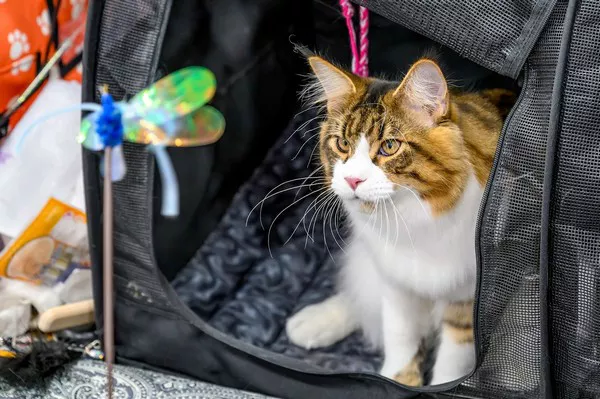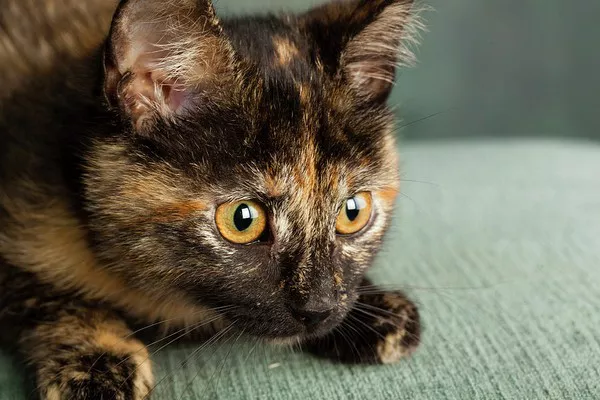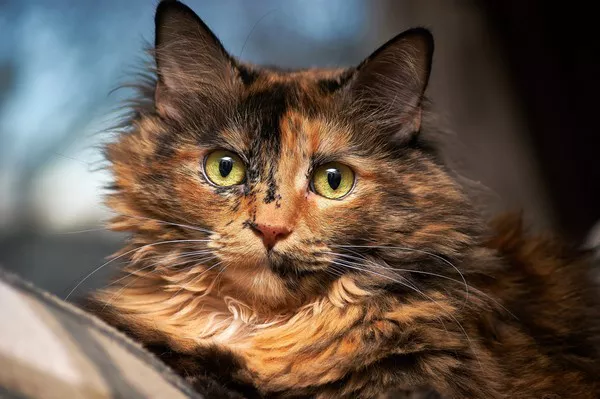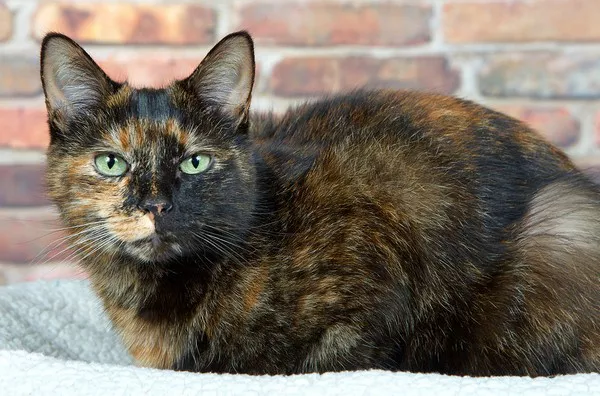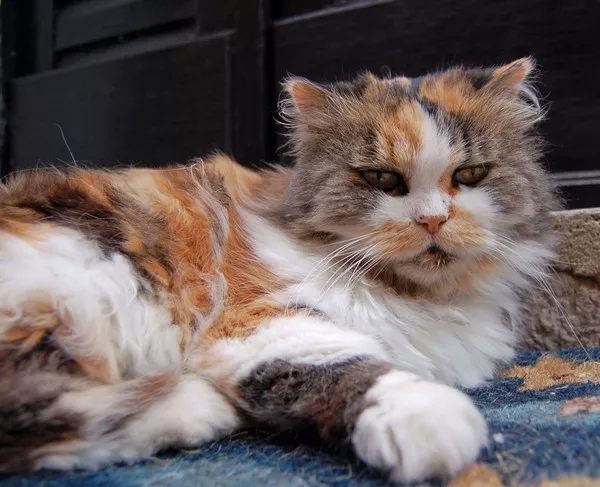Himalayan cats are renowned for their striking appearance, featuring long, luxurious fur, captivating blue eyes, and a distinctive brachycephalic (short-nosed) face. However, this beautiful breed is predisposed to several health issues that cat owners should be aware of. Understanding these common health problems is crucial for ensuring a Himalayan cat‘s overall well-being and longevity. This article delves into the prevalent health concerns faced by Himalayans, providing insights into their causes, symptoms, and preventative measures. We will also discuss the significance of regular veterinary care, nutrition, and a healthy living environment in maintaining optimal cat health.
1. Breathing Difficulties
Himalayan cats are classified as brachycephalic, which means they possess a short skull structure and broad face. This unique anatomical feature is visually appealing, but it often comes with health implications. The compression of nasal passages and sinuses in brachycephalic breeds can lead to various breathing difficulties, making it essential for cat owners to be vigilant about their pet’s respiratory health.
Himalayans may experience a range of respiratory problems, including:
Nasal Obstruction: The shortened nasal passages can become easily obstructed, leading to difficulty breathing, snoring, and even sleep apnea.
Increased Risk of Infections: The structural abnormalities can make these cats more susceptible to respiratory infections, as the normal drainage of mucus can be compromised.
Heat Intolerance: Due to their breathing difficulties, Himalayans may struggle to regulate their body temperature effectively, leading to overheating in hot weather.
Signs of Breathing Difficulties
Pet owners should watch for the following symptoms, which may indicate respiratory distress:
- Labored or noisy breathing
- Excessive panting or lethargy
- Nasal discharge or frequent sneezing
- Coughing or gagging
Management and Treatment
Regular veterinary check-ups are crucial for monitoring a Himalayan cat’s respiratory health. In some cases, surgical intervention may be necessary to correct severe airway obstructions. Providing a cool, stress-free environment can also help alleviate breathing difficulties, especially during warmer months.
2. Dental Malocclusions
Himalayan cats are prone to dental malocclusions, a condition where the teeth are misaligned. This misalignment can lead to various dental issues, including trauma to the teeth, periodontal disease, and difficulties in eating.
Dental malocclusions can have several repercussions for Himalayans:
Trauma to Teeth and Gums: Misaligned teeth may cause uneven wear or damage to other teeth, leading to painful injuries.
Periodontal Disease: Cats with dental malocclusions are at an increased risk of developing periodontal disease, which can result in tooth loss and systemic health issues if bacteria enter the bloodstream.
Nutritional Challenges: Difficulty in chewing due to misaligned teeth can lead to a decreased appetite, potentially resulting in nutritional deficiencies.
Signs of Dental Problems
Owners should monitor their Himalayans for signs of dental issues, which may include:
- Bad breath
- Difficulty eating or reluctance to chew
- Swollen or bleeding gums
- Excessive drooling
Preventive Care for Dental Health
Regular dental check-ups and cleanings by a veterinarian are essential for preventing dental malocclusions and related issues. Providing dental treats and toys can also help maintain oral health, while owners should brush their cat’s teeth regularly to reduce plaque buildup.
3. Cherry Eye
Cherry eye is a common condition in Himalayan cats, characterized by the prolapse of the third eyelid gland. This gland is responsible for producing a significant portion of the tear film, and its displacement can lead to irritation and other complications.
The exact cause of cherry eye remains unclear, but factors such as genetics and weak connective tissue in the gland are believed to contribute. Himalayans, due to their unique anatomical features, may be more susceptible to this condition.
Symptoms of Cherry Eye
Owners may notice the following signs if their Himalayan cat develops cherry eye:
- Redness or swelling in the corner of the eye
- Excessive tearing or discharge
- Squinting or pawing at the eye
- Increased sensitivity to light
Treatment Options
If cherry eye is suspected, it is essential to consult a veterinarian. Treatment may involve:
Surgical Replacement: In some cases, surgery may be necessary to reposition the gland properly.
Medication: Anti-inflammatory eye drops may help reduce irritation and swelling.
Proper care and prompt treatment are crucial to prevent complications, including potential damage to the eye.
4. Polycystic Kidney Disease (PKD)
Polycystic Kidney Disease (PKD) is a genetic condition that affects various cat breeds, including Himalayans. This disorder leads to the formation of numerous cysts in the kidneys, which can impair their function over time.
PKD is inherited in an autosomal dominant pattern, meaning that a cat only needs one copy of the defective gene from either parent to develop the condition. Genetic testing can help identify carriers of the PKD gene, allowing prospective cat owners to make informed breeding decisions.
Symptoms of PKD
As PKD progresses, affected cats may exhibit the following signs:
- Increased thirst and urination
- Weight loss despite a normal appetite
- Lethargy and weakness
- Vomiting or diarrhea
Management of PKD
While there is no cure for PKD, early detection and management can help maintain a cat’s quality of life. Regular veterinary check-ups, monitoring kidney function through blood tests, and a special diet may assist in managing symptoms and slowing disease progression.
5. Joint Problems and Deformities
Himalayan cats are susceptible to joint problems and deformities, often stemming from poor breeding practices. Inbreeding and a lack of genetic diversity can result in various skeletal issues that affect the cat’s mobility and overall health.
Some common joint-related problems in Himalayans include:
Hip Dysplasia: A genetic condition where the hip joint doesn’t fit into the hip socket correctly, leading to arthritis and pain.
Osteoarthritis: Degeneration of joint cartilage can occur over time, causing stiffness and discomfort, especially in older cats.
Signs of Joint Problems
Cat owners should observe their Himalayans for signs of joint pain, which may include:
- Difficulty jumping or climbing
- Limping or favoring a leg
- Reduced activity levels
- Behavioral changes, such as irritability or withdrawal
Prevention and Management
Regular veterinary check-ups and maintaining a healthy weight are crucial for minimizing the risk of joint problems. Providing joint supplements, such as glucosamine and omega-3 fatty acids, can also help support joint health.
6. Feline Hyperesthesia Syndrome
Feline Hyperesthesia Syndrome (FHS) is a complex neurological disorder that can affect Himalayans. This condition is characterized by heightened sensitivity of the skin, leading to excessive grooming, twitching, and unusual behavior.
Symptoms of FHS
Himalayan cats with FHS may exhibit the following signs:
- Excessive grooming or biting at the skin
- Skin twitching or rippling
- Hyperactivity or sudden bursts of energy
- Sensitivity to touch or handling
Potential Causes
The exact cause of FHS remains unclear, but potential contributing factors may include:
- Stress or anxiety
- Neurological abnormalities
- Allergies or skin conditions
Management of FHS
Managing FHS often requires a multifaceted approach, including:
Environmental Enrichment: Providing stimulation through play and interaction can help alleviate stress.
Behavior Modification: Consulting with a veterinarian or animal behaviorist can help address behavioral issues.
Medication: In some cases, anti-anxiety medications or sedatives may be prescribed to help manage symptoms.
Preventive Care
Regular Veterinary Check-Ups
Regular veterinary check-ups are essential for maintaining optimal cat health in Himalayans. These check-ups allow for early detection of potential health issues and provide an opportunity for vaccinations, dental care, and overall health assessments.
Proper Nutrition
Feeding a balanced diet is crucial for the overall health of Himalayan cats. A high-quality cat food that meets their nutritional needs can help prevent obesity and associated health problems. Consultation with a veterinarian can assist in selecting the right diet for your cat.
Maintaining a Healthy Environment
Creating a safe and healthy living environment for Himalayans is vital for their well-being. This includes:
- Providing a clean litter box
- Offering scratching posts and toys to encourage physical activity
- Ensuring access to fresh water at all times
- Keeping them indoors to reduce the risk of injury and disease exposure
Conclusion
Himalayan cats are a beautiful and unique breed, but they are prone to various health issues that require attention and care. Understanding common problems such as breathing difficulties, dental malocclusions, cherry eye, polycystic kidney disease, joint problems, and feline hyperesthesia syndrome is crucial for responsible pet ownership. By prioritizing regular veterinary care, proper nutrition, and a healthy living environment, cat owners can help prevent and manage these health challenges, ensuring their Himalayan cat enjoys a long and healthy life. Remember, proactive measures and attentive care are key to promoting optimal cat health in your beloved feline companion.
Related Topics

